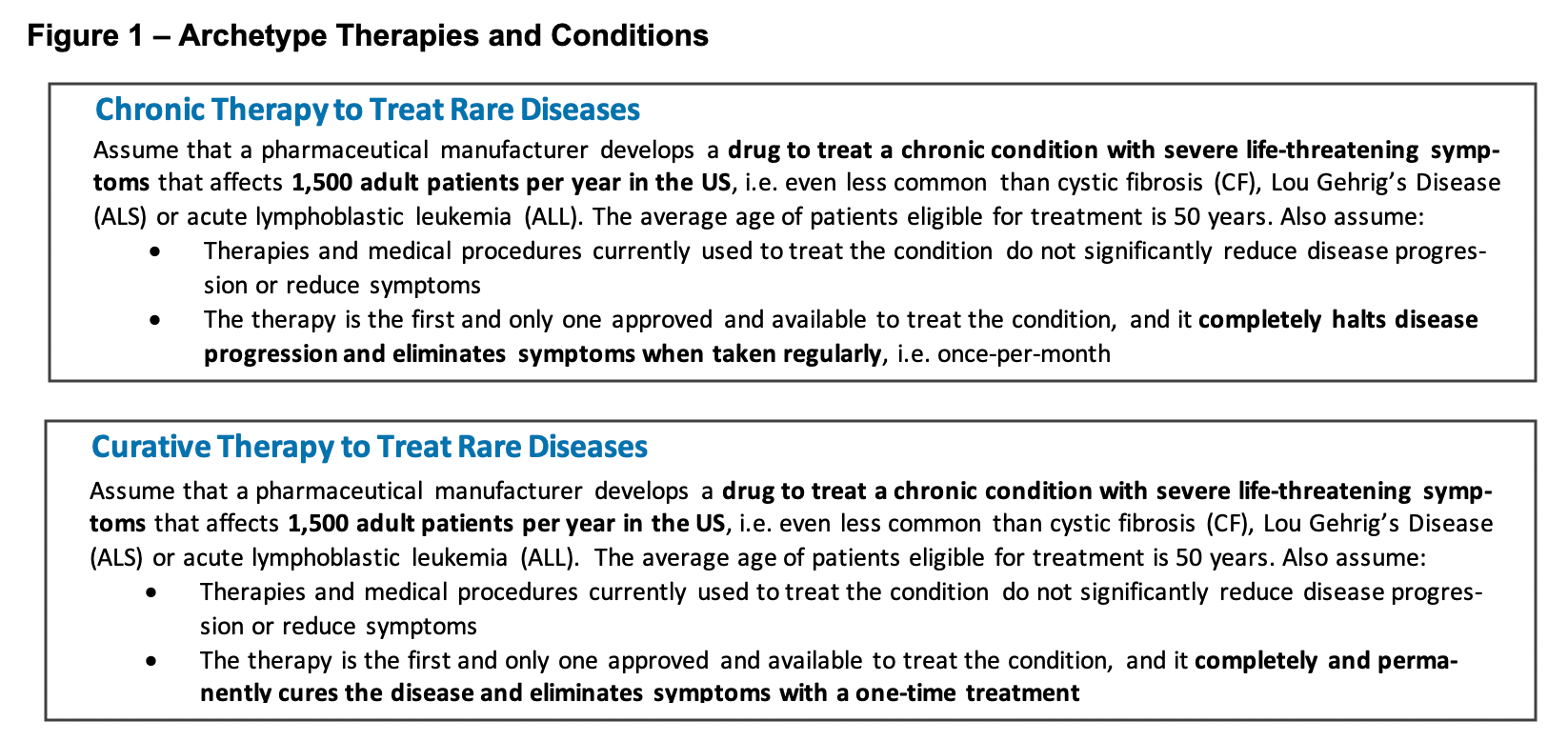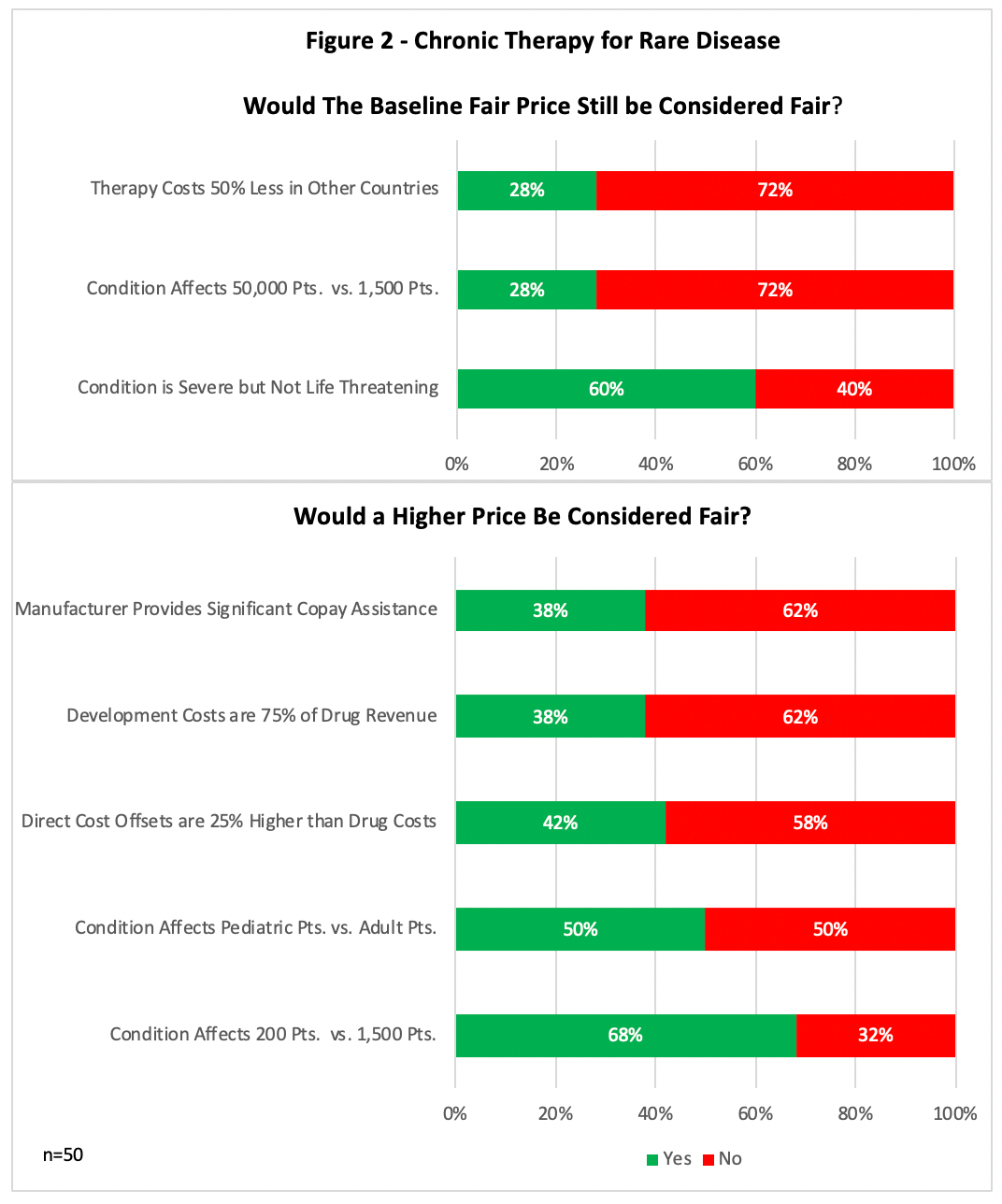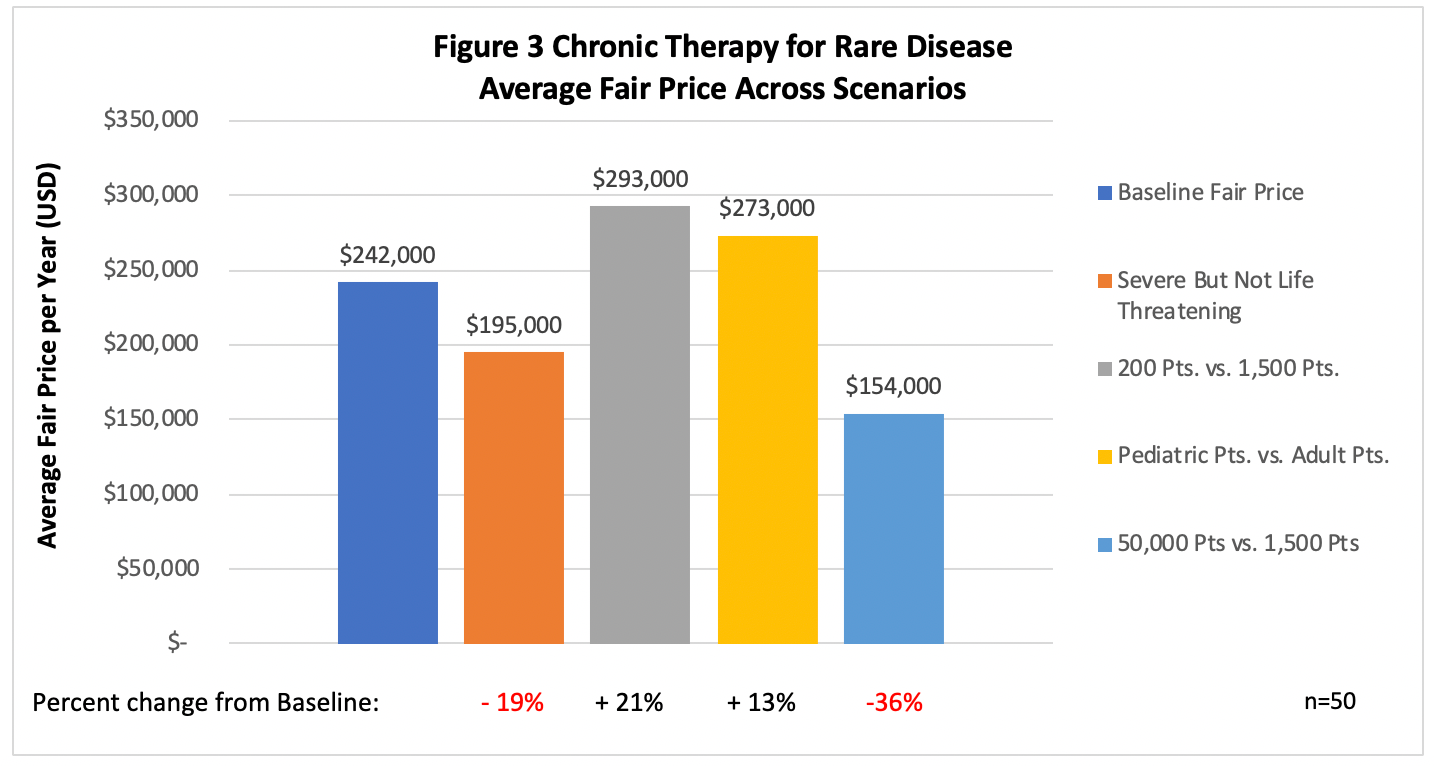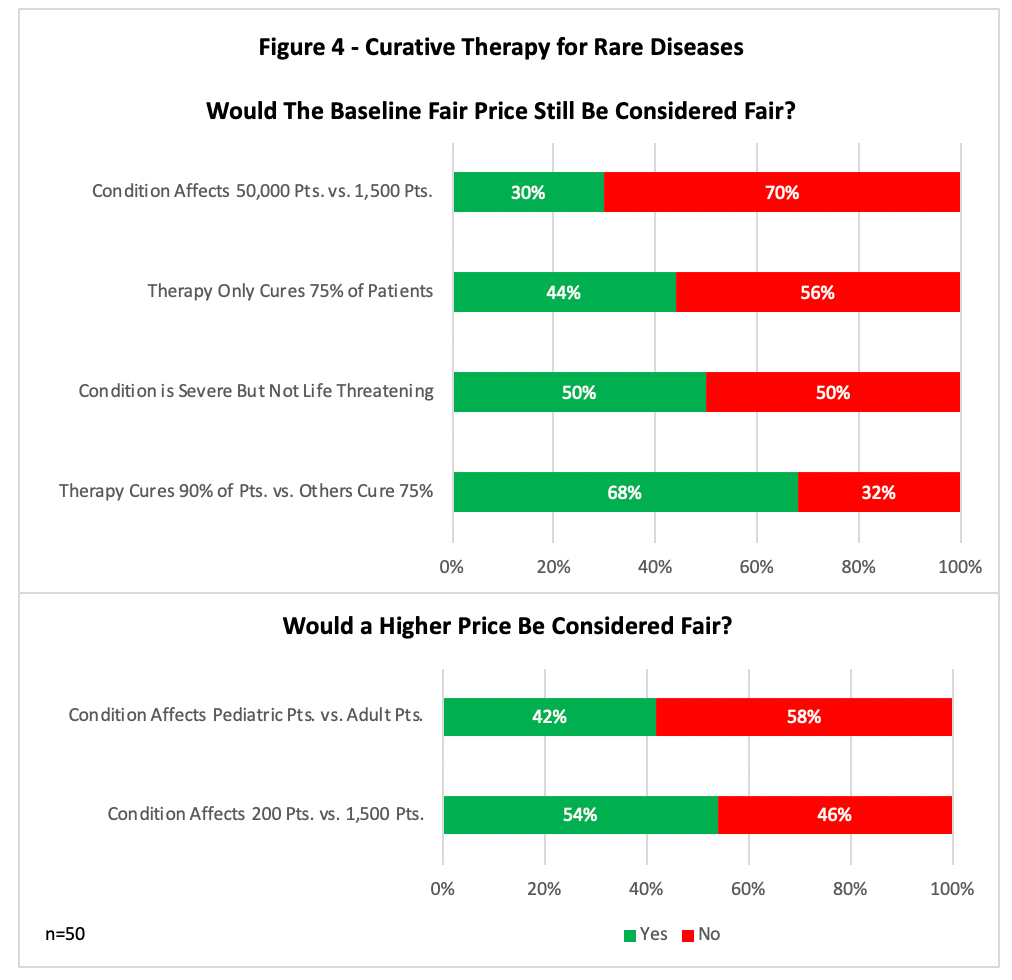Pricing for Rare Disease and Curative Therapies: What’s Fair?
There has been a considerable amount of attention given to the rising costs of pharmaceutical and biotechnology therapies in the US. In early 2020, Charles River Associates conducted this research to determine what "fair" prices would be for these therapies.
Introduction
The furor over the rising cost of pharmaceutical and biotechnology therapies in the US is accelerating. Several proposed policy and legislative initiatives aim to address the issue through new regulations and laws that would require mandates for price negotiations by government and private insurers, limits on price increases, and the introduction of international reference pricing.
As policymakers, payers and other stakeholders grapple with the question of what the healthcare system can afford to pay, the high cost and risk involved in developing innovative therapies has led to the question: what is fair? In their pioneering paper on the topic of fairness of pricing practices “Fairness as a Constraint on Profit Seeking: Entitlements in the Market,” Nobel Prize winning economists Daniel Kahneman and Richard Thaler, and co-author Jack Knetsch, provide a framework for identifying conditions under which fairness can be an important consideration when setting prices.
In early 2020, CRA conducted research with a broad range of US stakeholders – including payers, physicians, patients, pharma/biotech manufacturers and others – to evaluate what these stakeholders believe is fair with respect to prices of therapies to treat rare conditions. This article presents the findings from research with 50 payer representatives from large commercial health plans and pharmacy benefit managers (30 pharmacy directors and 20 medical directors from organizations with over 290 million total beneficiaries with pharmacy and medical coverage). The research was designed to provide insights into their perceptions of whether the prices of therapies are fair, and how perceptions of fairness depend on characteristics of the therapy, the condition, the patient population, existing price benchmarks and other attributes of the treatment and patient. We explored payer perceptions of fairness for chronic therapies to treat rare diseases and curative therapies for rare diseases.
To develop treatment archetypes for review by payers, we defined two therapies together with specifics about the patient population and condition. Figure 1 specifies the two archetypes, which were developed to provide sufficient detail for respondents to give feedback on what prices would be considered fair. Defining treatment archetypes allows us to evaluate a wide range of situations to identify the drivers of perceptions of fairness. It also avoids confounding interpretations of findings due to respondents’ pre-existing views about the prices or clinical performance of actual therapies. Separately from analysis of these treatment archetypes, our research obtained feedback from payers on the perceived fairness of several existing therapies.

Source: Charles River Associates Research and Analysis
Perceptions of fairness - baseline fair prices
The initial questions asked of payers identified the maximum price that would be considered fair for each of these archetypes, without any additional context or information. Respondents were asked whether specific price levels would be considered fair on a 4-point scale (very unfair, somewhat unfair, somewhat fair, very fair). Based on their answers, questions were asked to determine the maximum price that would be considered fair.
On average, respondents viewed prices of novel therapies for the chronic treatment of rare diseases as being fair if they did not exceed $242,300 per year. Similarly, for one-time curative therapies, the average maximum price considered to be fair was $692,500 per treatment. The prices identified by payer respondents as fair for the therapies and conditions in Figure 1, without any additional or alternative information, are referred to as “baseline fair prices”.
Effect of context on perceptions of fairness
Kahneman’s paper on fairness established the foundation for “dual entitlement” theory and demonstrated how perceptions of fairness are highly dependent on the circumstances of the transaction, considering the perspectives of both the buyer and seller. The theory posits that transactors have an entitlement to the terms of the reference transaction and firms are entitled to their profits. Three determinants of fairness judgements are identified: reference transactions, occasions for pricing decisions, and the outcomes to the firm and transactors. However, therapies to treat rare chronic diseases and curative therapies (e.g. novel gene and cell therapies) are unique – most have no clear “reference transaction” other than imperfect analogues. The focus of this research is on how perceptions of fairness vary based on occasions (or context) for pricing decisions and outcomes (degree of benefits, patient improvement). Our research sought to determine which of these factors associated with pricing therapies for certain rare conditions were most likely to affect perceptions of fairness.
After identifying “baseline fair prices” as those considered to be fair with limited context, alternative or additional information was provided to respondents to understand how their perceptions of fairness depend on varying characteristics of the therapy, the condition, the patient population, existing price benchmarks and other aspects of the treatment and patient context. For example, we varied the context to understand how perceptions of fairness depend on the specific situation, including whether: (a) the condition is life-threatening and/or severe; (b) the patient population is rare (e.g. 1,500 patients) or ultra-rare (e.g. 200 patients) and focused in adults or pediatric patients; (c) the level of clinical benefit or improvement in patient outcomes, and (d) benchmarks or references exist for prices of existing therapies, development costs, cost offsets, and patient affordability.
Chronic therapies for rare diseases – For these therapies several contextual elements were varied and respondents were asked whether the prices that they previously identified as being fair with limited context – their baseline fair prices – still would be considered fair, and whether higher prices would be considered fair. Figure 2 shows the percent of respondents who answered that the baseline fair price would no longer be considered fair when provided additional context, or that a price higher than the baseline price would be considered fair. For example, benchmark information such as “the therapy costs 50% less in other countries” or an alternative perspective on prevalence such as “the therapy is approved to treat 50,000 patients (versus 1,500 patients)” would result in the baseline price no longer being considered fair for a large portion of respondents (72%). In contrast, most respondents still would consider the price fair if the condition were severe but not life-threatening.
In terms of circumstances that could result in higher prices being considered fair, Figure 2 shows that most respondents would consider a higher price to be fair if the therapy were approved to treat a more rare condition, i.e. only 200 patients (versus 1,500 patients). Notably, only 38% of respondents would view higher prices to be fair if there were substantial copayment assistance to patients. Most respondents, 58%, would not view a higher price as fair even if the therapy were to reduce the cost of care, i.e. if direct cost offsets were 25% higher than the therapy cost, or if the drug’s development costs exceed 75% of the drug’s total revenue over time.
We also obtained the specific price that would be considered fair with the varied context, i.e. for those payers who responded that the baseline fair price would no longer be considered fair, or that a higher price would be considered fair. Figure 3 shows the prices that are considered by payers to be fair for therapies to treat rare chronic conditions, under different circumstances. When the condition is severe but not life-threatening, the average price considered by payers to be fair drops by 19%. When the therapy is approved for treating a population of 50,000 patients (versus 1,500 patents), the average price considered to be fair drops by 36%. Alternatively, when the context is defined so that the therapy would be approved for treating only 200 patients (versus 1,500 patients) the average price considered to be fair increases by 21%. The value of therapies to treat pediatric patients is apparent. Although Figure 2 shows that only 50% of respondents believed a higher price to be fair for a therapy that treated pediatric patients (versus adult patients), Figure 3 indicates that the fair price for a therapy that treats pediatric patients is 13% higher than one that treats adult patients.


Source: Charles River Associates Research and Analysis
Curative therapies for rare diseases – For curative therapies, different contextual elements were varied, and respondents were asked whether the prices that they previously identified as being fair – the baseline fair prices – would still be considered fair, and whether higher prices would be considered fair.
Figure 4 shows the proportion of respondents who answered that the baseline fair price would no longer be considered fair, or that a price higher than the baseline fair price would be considered fair. Additional context such as “the therapy would be used to treat 50,000 patients (versus 1,500 patients)” would result in the baseline fair price no longer being considered fair for a large portion of respondents (70%). Similarly, if the therapy could cure only 75% of patients, 56% of respondents indicated that the baseline fair price would no longer be considered fair. If the therapy could cure 90% of patients, while other therapies could cure only 75% of patients, 68% of respondents indicated that the baseline price still would be considered fair. Half of the respondents still would consider the price fair if the condition were severe but not life-threatening. In terms of circumstances that could result in higher prices being considered fair, most respondents (54%) would consider a higher price to be fair if the therapy were approved for treating only 200 patients (versus 1,500 patients). A smaller portion of payers (42%) would view higher prices to be fair if the therapy were indicated to treat pediatric (versus adult) patients.
For curative therapies, we also obtained the specific price that would be considered fair with the varied context, i.e. for those payers who responded that the baseline fair price would no longer be considered fair, or that a higher price would be considered fair. Figure 5 shows the prices that are considered by payers to be fair for curative therapies under different circumstances. Even though 50% of respondents believed the baseline price to be fair, when viewed in the context of a severe but not life-threatening condition, as shown on Figure 4, the average price considered to be fair drops by 28%. If the therapy is approved for treating a population of 50,000 patients (versus 1,500 patents), the average price considered to be fair drops by 33%. When the therapy is effective in curing only 75% of the patients, the average price considered to be fair drops by 18%. In contrast, when the context is defined so that the therapy would be approved for treating only 200 patients (versus 1,500 patients), the average price considered to be fair increases by 13%. Similarly, a slightly higher price is considered fair in a situation where the therapy cures 90% of patients, but there are existing therapies that cure only 75% of patients, demonstrating an increase in perceived fairness associated with an efficacy improvement over an existing standard of care. As with chronic therapies for rare disease, higher prices are considered fair for curative therapies when associated with pediatric patients. Although Figure 4 shows that only 42% of respondents believed a higher price to be fair for a therapy that treated pediatric patients (versus adult patients), Figure 5 indicates that the fair price for a curative therapy that treats pediatric patients is 23% higher than one that treats adult patients.

Source: Charles River Associates Research and Analysis

Source: Charles River Associates Research and Analysis
Are prices of existing therapies fair?
The payer research was focused on determining the drivers of perceptions of fairness. For that purpose, archetype treatment scenarios are useful for understanding views on fairness for a range of therapies, patient conditions and circumstances. Another issue is how payers and other stakeholders view the prices of actual therapies, given their clinical benefits and the value in improving patient outcomes. The views of payers about whether the prices of existing therapies are fair were explored to understand whether these views aligned with the findings for treatment archetypes. For each of the therapy types described earlier, four therapies that are approved and on the market were selected to determine whether payers view their prices as fair. These therapies span a range of list prices and prevalence of the underlying conditions. Payers who indicated that they are familiar with each therapy were asked to provide their view about whether the list price of the therapy is fair.
For therapies to treat rare chronic conditions, 20-46% of payers indicated the prices of actual therapies to be fair, while the prices of actual curative therapies were viewed by 32-49% of payers to be fair. The pricing of these therapies generally correlates with the prevalence of the conditions they are used to treat, in that higher-priced therapies tend to be those used to treat conditions with lower prevalence. For existing therapies with prevalence and other characteristics similar to the archetype treatment scenarios, the average payer responses on prices considered to be fair align with the assessments of fairness of prices for the archetype treatments.
Conclusions
The findings from research with 50 US payers suggests that novel therapies that effectively treat or cure rare diseases are valued by payers, as evidenced by their views on the prices that are considered to be fair for archetype treatments. On average, prices up to $242,300 per year for therapies used to treat rare chronic diseases are viewed as fair if they have unique, significant benefits in terms of patient outcomes. On average, curative therapies with such benefits are considered to be fair at prices up to $692,500 per treatment.
The research also shows that context matters when it comes to perceptions of fairness. Generally, higher prices are considered to be fair for therapies that are effective and approved to treat smaller patient populations or pediatric patients, and for therapies that significantly improve clinical outcomes. In contrast, lower prices are considered to be fair for therapies that are used to treat severe conditions that are not life-threatening, and therapies approved to treat significantly larger patient populations.
This paper reports the findings of research with payers, as part of a broader study aimed at understanding and comparing the views of a wide range of stakeholders (payers, physicians, patients and patient advocates, caregivers, pharma/biotech firms, media and trade journalists) about fairness of prices for therapies used to treat rare conditions. Greater insight about what such stakeholders view as fair can be used to inform innovators’ decisions about setting prices.
References
Kahneman, Daniel, et al. “Fairness as a Constraint on Profit Seeking: Entitlements in the Market.” American Economic Review, vol. 76, no. 4, 1986, pp. 728-741
McGraw, A. Peter, et al. “From the Commercial to the Communal: Reframing Taboo Trade-Offs in Religious and Pharmaceutical Marketing.” Journal of Consumer Research, vol. 39, no. 1, 2012, pp. 157–173
Piron, Robert, and Luis Fernandez. “Are Fairness Constraints on Profit-Seeking Important?” Journal of Economic Psychology, vol. 16, no. 1, 1995, pp. 73–96
Trujillo, Antonio J., et al. “Fairness in Drug Prices: Do Economists Think Differently from the Public?” Health Economics, Policy and Law, vol. 15, no. 1, 2018, pp. 18–29
Vogler, Sabine. “Fair Prices for Medicines? Exploring Competent Authorities’ and Public Payers’ Preferences on Pharmaceutical Policies.” Empirica, vol. 46, no. 3, 2019, pp. 443–469
Xia, Lan, et al. “The Price Is Unfair! A Conceptual Framework of Price Fairness Perceptions.” Journal of Marketing, vol. 68, no. 4, 2004, pp. 1–15
Authors
The views expressed in this paper are those of the authors and do not represent the views of Charles River Associates. To learn more about this study, please contact aparece@crai.com.
Andrew Parece, Vice President, CRA, Matthew Majewski, Vice President, CRA, Kristen Backor, Director, CRA, and Joseph Black, Associate Principal, Life Sciences Practice, CRA
The Misinformation Maze: Navigating Public Health in the Digital Age
March 11th 2025Jennifer Butler, chief commercial officer of Pleio, discusses misinformation's threat to public health, where patients are turning for trustworthy health information, the industry's pivot to peer-to-patient strategies to educate patients, and more.
Applying Porter’s Five Forces to Portfolio Management in Pharmaceutical R&D: A Strategic Roadmap
March 17th 2025The increasing costs and complexity of R&D in the pharmaceutical industry have necessitated the adoption of strategic portfolio management to optimize resource allocation and enhance competitive advantage.
Navigating Distrust: Pharma in the Age of Social Media
February 18th 2025Ian Baer, Founder and CEO of Sooth, discusses how the growing distrust in social media will impact industry marketing strategies and the relationships between pharmaceutical companies and the patients they aim to serve. He also explains dark social, how to combat misinformation, closing the trust gap, and more.